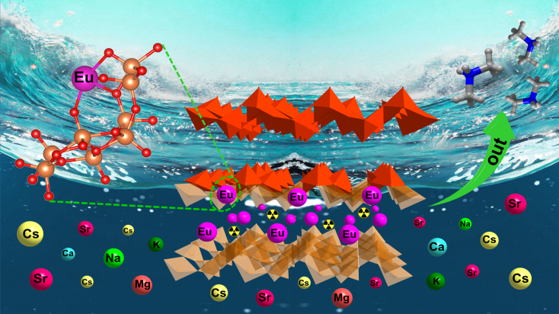
With the development of nuclear energy, environmental concerns associated with the nuclear fuel cycle has attracted great attention. However, the effective sequestration of actinides and lanthanides (Ln) from complex radioactive wastes, especially the high-level liquid waste (HLLW) under strong acidic conditions, remains a serious challenge.
In a study published in Angew. Chem. Int. Ed., Prof. FENG Meiling from Prof. HUANG Xiaoying’s research group at Fujian Institute of Research on the Structure of Matter of the Chinese Academy of Sciences reported the first crystalline simple vanadate adsorbent, namely [Me2NH2]V3O7, for the recovery of lanthanides from aqueous solutions.
The researchers found that [Me2NH2]V3O7 possesses many outstanding features including wide pH durability, high radiation resistance and adsorption capacity.
In the solution with the pH range of 1.9 – 12.3 or under 200 kGy β or 50 kGy γ irradiations, it can maintain the robust layered structure of [V3O7]nn-. The distribution coefficient (Kd) value for Eu3+ could maintain 1.72 × 105 mL/g at the pH as low as 2.5. The Kd and removal rate (R) values for Eu3+ basically maintain after β or γ irradiations. Even at low pH, [Me2NH2]V3O7 displays high adsorption capacities for lanthanides. It still retains high capacity at low pH of 2.5, which is rarely accomplished for most of the present adsorbents.
Besides, [Me2NH2]V3O maintains high KdEu values from 4.35 × 104 mL/g to 7.47 × 104 mL/g and high REu in the range of 97.75 – 98.68% in the presence of excessive Na+, K+, Ca2+ and Mg2+. In particular, it can efficiently separate Eu3+ from Cs+ (or Sr2+) with the highest separation factor SFEu/Cs of 156 (SFEu/Sr of 134) to date.
The lanthanide ion Eu3+ is widely studied as the simulant for long-lived radiotoxic actinides for their similar adsorption properties. In the exchanged products, Eu3+ can be effectively eluted with low-cost, environmental-friendly and safe method, and the removal rate by recycled product could still remain. These merits combined with facile synthesis make this vanadate a promising lanthanide scavenger for environmental remediation.
The researchers revealed the adsorption mechanism at the atomic level by theoretical calculations in combination of various characterizations such as X-ray photoelectron spectroscopy (XPS) and extended X-ray absorption fine structure (EXAFS) spectra analyses, and Raman and elemental analyses, providing microscopic elucidation for the selective adsorption of Eu on this vanadate.
This study provides an easily-synthesized layered vanadate that could highly and selectively recover lanthanides from aqueous solutions, and emphasizes the importance of developing crystalline vanadate materials for the applications in the field of environmental remediation.

Selective recovery of lanthanides by a crystalline simple vanadate with acid- and radiation-resistance (Image by Prof. FENG)

86-10-68597521 (day)
86-10-68597289 (night)

52 Sanlihe Rd., Xicheng District,
Beijing, China (100864)

